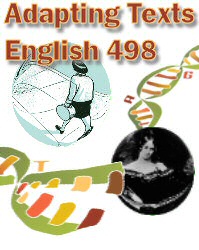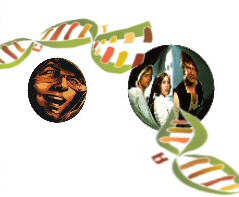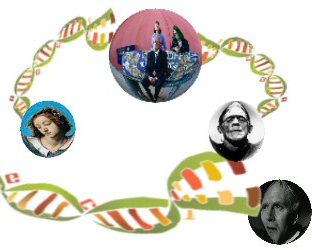 |
 |
 |
 |
|
Sample Frankenstein Case StudyFrankenstein vs. the Monster: A Struggle for Sympathy In his 1931 film adaptation of Mary Shelley’s Frankenstein, James Whale endeavors to emphasize the tragedy of the creature Frankenstein creates. To accomplish this emphasis, Whale adapts Shelley’s characters of Frankenstein and the monster though his cinematic interpretation and presentation. While both characters experience tragic events in Shelley’s story designed to present both characters sympathetically to the reader, Whale alters events and aspects of the story in such a way that singles out the monster as the main tragic character of the film. An analysis of the adaptation theory of McFarlane gives us an idea of how Whale achieves his goal. According to McFarlane, there are elements in Shelley’s novel that are adequately transferred while other must be adapted. Whale chose to transfer the elements that invoke a compassionate response from the audience for the monster and adapt other elements for likewise purpose. In the case of the creature, Whale transferred several elements about its appearance, the most important of which is its size and hideousness. He also adapts other physical aspects; he adds the neck-bolts and stitches to emphasize the artificialness of the creature’s creation. Its eyes nearly roll into its forehead, giving the impression it is possessed by some evil demon. These aspects are important to the creature because they are the most immediately frightening characteristics of the creature. To make the creature sympathetic, Whale needed to present the creature in a such a way as would be immediately shocking to both the audience and the other characters in the film, thus guaranteeing a reason for the film characters and the audience to judge the monster harshly just from appearance. This way, the audience would subconsciously feel some kind of guilt when they see in the characters of the mob just how far such a mindset of rash judgment can go in hurting an arguably innocent being due to a prejudiced misunderstanding. In order to invoke a sympathetic understanding for a creature so terrifying in its appearance, Whale focused on the child-like nature Shelley’s monster described himself possessing early in his life. Since such a quality is explained in the novel through narration, Whale transferred this general idea and used adaptation to expound upon it in order to bring this aspect to life in cinema where he did not have the benefit of worded narration. While he looks menacing with his huge size, hideous appearance, and lumbering, looming stance, the creature moves with a slow caution of unsurely and communicates with gentle, pleading gestures of his enormous hands. It demonstrates an eagerness to learn and explore, such as in the case with the sunlight experiment where Frankenstein exposes the monster to light for the first time. As the monster moves through the story, most of its actions are guided by its innocent curiosity, such as how it sneaks up behind the unsuspecting Elizabeth with a look of fascination upon its face. While the monster’s curiosity can be seen in Shelley’s early depictions of the creature as well, Whale’s monster is deprived of one of its biggest redeemable qualities: its intelligence. It is given a criminal brain—supposedly adequate for nothing but evil; this enforces the idea that the creature is created into a doomed existence without a chance to save itself from the inevitable result of its construction. Whale also adapts the evidences of the intelligence of Shelley’s creature in such a way that preserves the child-like naivety of the monster—he deprives it of its ability to speak. This restriction also makes the monster seem much more pathetic and helpless, since it cannot even explain its actions as it could in the novel. All it can do is wave its arms in a vague plea for understanding. Because the monster is so naïve, it has little concept of the consequences of its actions, nor does it appear to harbor the same level of murderous hatred as Shelley’s monster. The monster never indents to commit evil, nor does it seem to be aware of the evil it commits. Even the murders dealt by the monster appear to not be entirely the creature’s fault. The creature never takes a life other than in self-defense—such as in the case of Fritz’s torments with fire and the professor’s attempt to dissect the creature—or by accident, such as in the case of the little girl. It never commits pre-meditated murder. Whale depicts the death of the little girl as an innocent misunderstanding—something that never happened to Shelley’s creature—and the monster appears to become horrified when he realizes that he may have harmed the little girl. As the third death illustrates, Whale’s creature is at a disadvantage because of his childish ignorance; its most compassionate quality becomes its tragic flaw. He struggles to understand simple concepts that the other characters take for granted, such as sunlight and floating flowers. Even when the monster goes after Frankenstein, it does not seem to have a clear idea of what to do with him. As for Frankenstein himself, to understand the change in sympathetic focus between the film and the source text, an analysis of the character of Frankenstein is also important. One of the biggest factors in establishing sympathy for the creature is the amount of sympathy the reader or viewer has for its creator. The novel presents both as tragic heroes, forcing the reader to choose (consciously or subconsciously) whose side to root most for. The reader’s sympathy is divided between the characters. The film intentionally establishes just the creature as the tragic hero and therefore directs the viewer’s sympathy entirely in that direction by enforcing the darker aspects of Frankenstein’s acts and eliminating the sympathetic tragedy he lives through in Shelley’s novel. To contrast Frankenstein from his creature, Whale uses similar adaptation techniques to bring out the darker aspects of Frankenstein’s character. The elements Whale chooses to transfer and adapt alter the audience’s perception of Frankenstein from the character in the novel. He comes off more like an eccentric madman than a passionate and sensitive individual. Whale transfers the novel’s narrative description of Frankenstein as a temporary madman, blinded to his corruption by his obsession, and brings these characteristics to life on screen in such a visually horrific way that the novel was unable to portray. Whale transfers references to the horrific morally-corrupt acts that Frankenstein commits in the creation of his monster and adapts those references for the screen by visually depicting scenes where Frankenstein collects parts for the creature’s body. His methods of collection were left unexplained in the novel; therefore the reader only knows where he acquired the parts; the gory details as to how he collected them are absent. In his film, Whale adapts these references and depicts the gruesome acts of Frankenstein collecting parts from bodies barely buried by a loving family in mourning and sending his assistant out to steal from the nearby university. Upon the completion of his monster, Whale’s Frankenstein does not immediately perceive the atrocious breach in moral and social standards that he had committed. He does not seem to suffer much moral regret either—he simply becomes disgusted with his project over time. In addition, his captive audience doesn’t appear to be too mortified at the concept of creating a creating from corpses—if anything, the doctor appears to become rather excited about this discovery later when he endeavors to dissect the monster. Through the entire animation scene, not one person voices concern about the morality of this act. It is as though the society in which Frankenstein lives also has no immediate problem with the creature’s creation—an impression that didn’t exist in the novel since nobody knew about the monster through most of Frankenstein’s narrative. Indeed, society in the film does not seem to even blame Frankenstein entirely for the creature; the mob focuses all its violence toward the monster rather than demanding that Frankenstein be held accountable for its creation. They even care for the injured Frankenstein when he falls from the windmill while shouting exuberantly as the flames engulf the structure and the monster. The mob brings into sharp relief the unfair shift of guilt entirely from Frankenstein to the monster. Whale’s Frankenstein also loses sympathy because he no longer experiences the tragic emotional trauma that connected him so empathetically with the creature in the source text. He does not loose any members of his family and the only two friends he looses to the monster died because they provoked the monster through their own cruel or insensitive actions. Frankenstein does not even experience the guilt and hatred in Shelley’s novel that drove him eventually to his death. As a result, Frankenstein does not experience the same feelings of loss and loneliness that the monster does. The monster suddenly is left on his own with no tragic foil or counterpart who could identify with it. This is how Whale adapts the loneliness of the creature without its narrative observations as to its singular existence and the unfairness that all other creatures can find companionship but him. With its creator thus emotionally distanced from understanding the creature, the monster is truly alone in the world. Whale transfers the loneliness and doom the creature feels because of its creation to the screen by adapting the monster into a child-like creature who is entirely a victim of circumstance. The creature appears even more pathetic as Whales adapts Frankenstein, the creature’s tragic counterpart, into an unsympathetic “monster” himself. In Shelley’s novel, both Frankenstein and the monster suffer from some form of horrible monstrosity. The monster suffers because he appears monstrous, and Frankenstein suffers because he has done something monstrous. Both also have redeemable qualities that, if considered, could make up for their monstrosity. The monster insists he possesses a kind and gentle nature and is in his speech an educated and civil-sounding fellow. Frankenstein fully regrets his actions, learned from his experience, and risks the wrath of the monster and even his own life in his efforts to avoid repeating his horrible experiment. The film begins in a similar manner; to the audience, both characters are portrayed as monstrous in their first appearance on screen—Frankenstein because of his horrific actions in the graveyard and the creature because of his horrific appearance. As the film progresses, Whale’s adaptation bends and adapts these aspects of the characters so that only the monster is forgivable for its monstrous qualities through it’s enforced child-like innocence. Frankenstein simply abandons his project and attempts to return to a normal life, showing almost no remorse for his actions other than to acknowledge his regret in neglecting his family. Since he never loses his family and never fully understands the creature, Frankenstein ends up joining the faceless mob in its prejudiced persecution of the monster. While Shelley’s monster’s fate is tied to its creator, Whale’s monster dies alone with no company in its misery. With such a sympathetic fate, Whale ensures the monster as the single tragic hero of his film. Copyright 2006 Amber McMullin. Last Update: 6/21/06
|